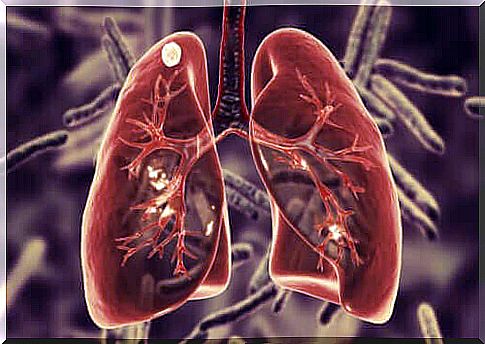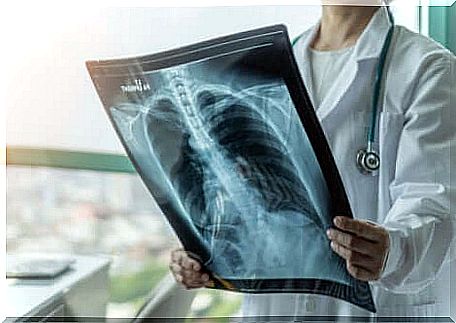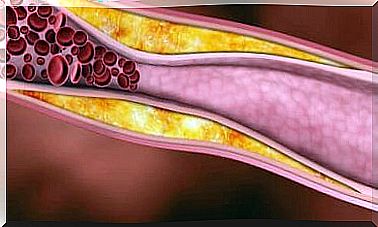What Is Pulmonary Tuberculosis And What Are Its Symptoms?

Pulmonary tuberculosis was a very serious public health problem in the early 20th century. An estimated one in seven people died from it. Thanks to drug development, the disease has been under control since the 1940s.
However, infections break out from time to time. Pulmonary tuberculosis remains a problem worldwide, especially with the emergence of a variant called multidrug-resistant, which is difficult to treat.
What is pulmonary tuberculosis?
Pulmonary tuberculosis is a disease caused by Mycobacterium tuberculosis . Most often, the microorganism in question settles in the lungs, but it can also affect other organs, such as the brain and kidneys, as well as the spine.
The important thing is that the actual pulmonary tuberculosis and the latent infection are different things. The former is the traditional form of the disease, while the latter is a condition in which the tuberculosis bacterium is present in the body, but it does not cause the disease itself, as if it were in a dormant state.
Most people who inhale the bacteria have an immune system that is able to fight them and prevent them from multiplying. However, the microorganism is still present in the body, although there are no symptoms.
These bacteria can remain inactive for years or even a lifetime. But if the immune system is weakened for any reason, they become activated, multiply, and cause a potentially life-threatening disease, pulmonary tuberculosis.

Causes of pulmonary tuberculosis
Pulmonary tuberculosis is a contagious disease because it is caused by bacteria. This means that an infected person can spread it to another person who does not have the infection. If the infection is latent, there will be no spread.
Infection occurs through saliva droplets when a person with the disease coughs or sneezes. Many recover from pulmonary tuberculosis without serious illness. In some cases, the infection reactivates as early as a few weeks after it appears.
Pulmonary tuberculosis: what are the risk factors?
Some people are at higher risk of developing pulmonary tuberculosis. These are the following Groups of People:
- Small children: Under 2 years old.
- Elderly: Over 60 years of age.
- Weakened immune system: Either due to diseases such as HIV and diabetes, or due to medication or chemotherapy.
The risk of developing pulmonary tuberculosis increases if a person suffers from malnutrition, lives in unhygienic conditions or comes into contact with infected people. Outbreaks are also more common in communities with more HIV patients, homeless people, or resistant bacterial strains.
Non-risk factors
Thus, a person with a latent infection will not spread the disease to other people, as already stated. Tuberculosis is also not spread by handshake or personal items (toothbrush, dishes, etc.).
Pulmonary tuberculosis is also not spread through shared food or drink, kissing, using a shared toilet, or through the bed of an infected person. Surfaces touched by a pulmonary tuberculosis patient do not need to be disinfected.
How is pulmonary tuberculosis symptomatic
The most common symptom of pulmonary tuberculosis is a severe cough that can last for more than three weeks. It is usually associated with bloody sputum. She is very ill and has the following symptoms:
- Chest pain
- Weakness or exhaustion and loss of appetite, leading to weight loss
- Fever and chills and night sweats
- Wheezing and difficulty breathing
Some patients with pulmonary tuberculosis also have the so-called fingers of Hippocrates in advanced stages. The tips of the fingers are enlarged, the fingers are shaped like drumsticks (so-called drum block fingers), and there is a change in the angle of growth of the nail.
Sensitive or swollen lymph nodes in the neck and other parts of the body are also common. In addition, the patient may have pleural effusion, i.e., fluid around the lungs. In some cases, complications such as hepatitis, brown or orange tears and urine, rash, and changes in vision occur.

Early detection improves prognosis
The latent infection does not cause any symptoms or any discomfort to the patient. A skin test or blood test reveals tuberculosis when a patient is examined for other reasons. Even if there are no symptoms, it is important to start treatment to prevent the disease from progressing.
When pulmonary tuberculosis is detected early and treatment is started in time, the prognosis is excellent. The symptoms usually disappear within two or three weeks. Failure of treatment has fatal consequences.









